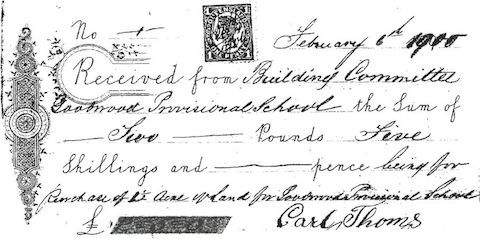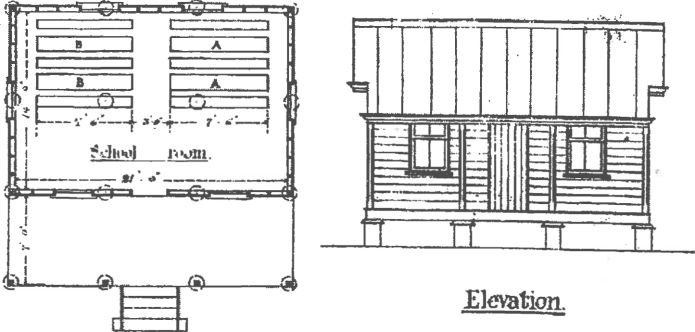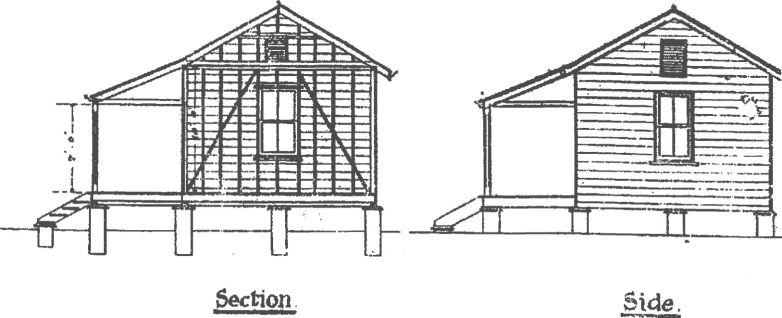On October 7th 1899, a meeting was held at Mr Blissett's residence and a committee was elected.
Several months of negotiation took place. The
Goodwood Committee wanted a State School, whose numbers would have to
average thirty, rather than a Provisional School. A Provisional school
was one which was funded by the local community and built to an
acceptable standard, the Department supplying the teacher and materials
used for instruction. The Department of Public Education would not have
approved any school if only a handful of children had been likely to
attend.
On the documents sent by the Secretary, Mr
Gibson, to the Department, thirty-four local children were listed as
likely to attend. This list of students included thirteen children who
lived at Isis Junction and attended school at Howard, travelling each
day by train. Along with the letter was a map of the district, showing
the proposed site. Mr Gibson wrote a long letter explaining the need for
a school, stating that as well as the above numbers, there were in the
Goodwood area, "twenty [other children] under the age of five years...the district is a rising one, the Goodwood Sugar Estate employing a large number of men all the year round, being within one and a half miles of the proposed site”.
“There are many
settlers in the neighbourhood engaged in various forms of agricultural
pursuits. In addition we have in the vicinity of the proposed site a
large area of good agricultural Crown Land already surveyed and open for
selection. Settlement on those lands has been greatly retarded owing to
the danger and inconvenience of sending very young children such a long
distance to a school. We believe that if a State School is erected, the
above lands would be quickly taken up from the Government, and would in
a comparatively short time become very closely settled.” He also added
that the "proposed road running East-West” … [Woodgate Road] … is now
well formed … ”
The Department then sent the Under Secretary of
the Department of Public Education, Mr George Harrap, to inspect the
area. In his report dated 30th December 1899, he scoffed at the
suggestion that Isis Junction children would come to Goodwood by train
rather than continue to attend Howard. He also anticipated that the
children who lived near the Goodwood Station would continue to catch the
8.45 am mail train to Howard, returning each afternoon at 5.45pm. In
this he proved to be incorrect.
With regard to other families in the area, such as Leeson, Voges, Louie and Amalie Rackemann and others, he noted that eight children live on the south side of the Gregory, and in ordinary weather can cross [the river] by means of fallen trees.”
But
he also noted that even after one day of rain, the river could not be
crossed at all. Nevertheless, he gave a glowing account of the
suitability of the suggested site, stating that “as a site for a school, it would be difficult to beat." Ultimately, he recommended the establishment of a Provisional School at Goodwood.
Approval was gained and land surveyed. Mr Carl
Thoms [Senior], one of the district’s earliest residents, donated one
acre of land in February 1900, and then sold a further one and a half
acres to the Building Committee for a total of £2-5-0. Carl and his wife
Carolina and family had arrived in Australia in 1863.

ABOVE: Copy of the original receipt for the sale of land to the school committee.
Three of their children were Carl [Junior],
Bertha [later Mrs Tom Leeson] and Auguste [later Mrs Christan Burow],
The younger Carl, whose son August was
a student at Goodwood from 1902 to 1906, eventually bought cane farms
in the Bullyard and Branyan areas.
The Committee continued to raise funds any way it
could. Soon tenders were called, the successful contractors being
Messrs Howard & Dickinson of Pallas St, Maryborough, who contracted
to erect the school to the specifications for a cost of £112. The
dimensions of the classroom were 18 feet by 22 feet [approximately 5.5
metres by 7 metres]. After some delays occurring in the Lands Department
over the transfer of title, work began in August 1900, being completed
by September 10lh 1900. The cost was £114-5-0, most
of which was met by Government subsidy, leaving the Committee with a
healthy bank balance of about £40.


ABOVE: The plans for the original Goodwood School.

ABOVE: Plans for the original amenities block.
The Building Committee minutes of October 17lh 1900 record the following: “The Secretary said that he had been approached by several of the residents to know if it was the intention of the Committee to celebrate the opening of the school. It was resolved that the committee take no action at present. ’’
Items noted to be purchased for the school were;
one millet broom, one galvanized iron bucket, twelve yards green window
binding, six spring rollers three feet long, one enamel cup, one hand
bell, two towels. [The purchase of the bell was however held over to a
later date]. The School was now ready to open.
This article first published in "Visions and Dreams: The Centenary of Goodwood State School 1900 - 2000", pp 13-15, compiled by Robyn Housechildt and Sonia Furlonger.